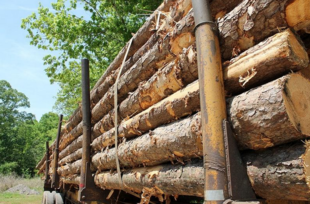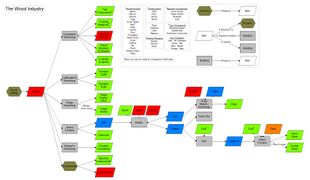- v50 information can now be added to pages in the main namespace. v0.47 information can still be found in the DF2014 namespace. See here for more details on the new versioning policy.
- Use this page to report any issues related to the migration.
DF2014:Wood industry
| This article is about an older version of DF. |
The wood industry deals with the harvesting and use of wood and wood-derived products: ash, potash, pearlash, and charcoal. Dwarves prefer to use stone or metal when possible, due to their durability and variety. Wood is weak by comparison (and usually flammable), but it is lightweight and sometimes preferred for bins, wheelbarrows and minecarts while being a renewable resource and sometimes the only option available for making certain items before the metal industry starts up.

Log Production[edit]
Finding trees[edit]
Most biomes with soil on the surface have trees growing on them. Surface trees will randomly spawn in surface soil. Underground trees (actually forms of giant fungus) also exist in the caverns beneath the surface. Underground trees will randomly spawn in any underground muddy soil once the appropriate cavern level is breached. Some rare trees will only grow in certain biomes, or ones with a particular alignment, or underground.
Tree Farming[edit]
Tree farming is a matter of patience and luck, more than resources or skill, since saplings spawn completely at random. The best that you can do is isolate a suitable area, ensure random dwarves and critters don't trample the saplings, and hope the trees grow. On the surface, this could involve walling off a section of forest or digging to cut off a wooded area from regular contact, creating an artificial plateau or hill only accessible through some other means (like a drawbridge or a locked hatch). Underground, you'll need to breach a cavern, and dig out a room in a soil layer, or muddy a rock layer with irrigation.
Woodcutting[edit]
Once you have located a source of trees, all you need to get started are two dwarves and a battle axe - designate the trees to be chopped down, and enable the wood cutting labor on the first dwarf. Provided the dwarf can reach the tree and the axe, the dwarf will go get the axe, go to the tree, and start chopping. A second dwarf with the wood hauling labor will then haul the resulting log back to a wood stockpile. The quality and material of the axe is not relevant to wood cutting - even a wooden training axe can fell a tree.(Note as of 0.43.03 this is not the case, you need a real battleaxe to chop down trees.)
Trading[edit]
Most caravans will bring logs, particularly if your wood supply is low. Trading for logs can save your dwarves the time and risk of harvesting their own, or supplement their production if the local area is sparse or your fortress is operating wood-intensive industries (such as metalcrafting without magma). Traders may also bring varieties of wood that your local biome cannot provide (such as feather tree). Note, however, that trees that only grow in evil biomes (glumprong) or below the first cavern level (black-cap, blood thorn, goblin-cap, nether-cap, spore tree, tunnel tube) will never be available for trading, since no trading race lives in an evil biome or penetrates the second cavern level.
A Log Is A Log[edit]
For the most part, all wood is effectively interchangeable - an oak log can be used to make all the same things as an alder log. However, certain woods have distinct properties (such as color and density) that may make them more aesthetically pleasing or useful in certain specific applications. Nonetheless, it's possible to specify the type of wood being used for a task, by pressing d and selecting the material.
Color[edit]
Most logs are brown-any furniture, objects, or buildings made from them will be brown as well. However, some trees will yield logs of a different color, so objects made from those logs will share that color. The following colors besides brown are available: black (Black-cap), cream (feather tree), crimson (Blood thorn), indigo (Nether-cap), lemon (Fungiwood), purple (Glumprong), red (Goblin-cap), teal (spore tree), violet (Tunnel tube), and white (Tower-cap).
Temperature[edit]
Wood can catch on fire, and generally should not be used around magma or dragons. Nether-caps, however, have a fixed temperate set just around freezing. Because of this fixed temperature, items made from nether-caps are both fire and magma safe. Fire can devastate a food stockpile filled with wooden barrels, so the use of metal or nether cap barrels should be considered if fire is a concern. Enormous corkscrews and pipe sections made from nether caps are also magma-safe and can be used in a magma pump if other magma-safe materials are in short supply.
Weight[edit]
The weight of a wood log or wooden object is based on the density of the wood. The average density is ~0.575 g/cm^3, but some species have much higher or lower densities than this average. Feather tree wood is the lightest in the game, with a density of 0.1 g/cm^3, making it ideal for crafting wooden training weapons and items that need to be moved frequently, such as buckets, barrels, and bins. Blood thorn (1.25 g/cm^3) and glumprong (1.2 g/cm^3) are the densest woods in the game, and are considered more appropriate for ballista bolts or other weapons where weight influences damage.
Uses of Wood[edit]
Wood logs may be used directly as a building material, where it is as good as stone or metal for most purposes, though generally less valuable. Logs may also be turned into various useful objects at the following workshops:
|
Used for creating wooden crossbows Used for creating:
|
Used for creating:
Used for creating siege engine parts |
Used for creating: Used for constructing: |
Wood Products and Related Industries[edit]
Aside from its use in crafting objects or building, wood may be changed into a variety of substances essential to the glass, soap and metal industries.
Ash[edit]
One log of wood can be used to create one bar of ash at a wood furnace by a dwarf with the wood burning labor enabled. Ash may be turned into either lye or potash at an ashery.
Lye[edit]
One bar of ash may be used to create one bucket of lye at an ashery by a dwarf with the wood burning labor enabled. This task requires an unused bucket. Lye may be combined with tallow to make soap, or converted into potash.
Potash[edit]
One bar of ash or one bucket of lye may be used to create one bar of potash at an ashery by a dwarf with the potash making labor enabled. Potash may be used as fertilizer on a farm plot, or converted into pearlash at a kiln.
Pearlash[edit]
One bar of potash may be used to create one bar of pearlash at a kiln by a dwarf with the furnace operator labor enabled. This task consumes one bar of fuel as well. Alternatively, a magma kiln can be used, in which case no fuel is required. Pearlash is used exclusively in the glass industry for making items out of higher-value glass.
Charcoal[edit]
One log of wood can be used to create one bar of charcoal at a wood furnace by a dwarf with the wood burning labor enabled. Charcoal is a fuel and is used extensively in the metal industry and glass industry.
| Primary | |
|---|---|
| Secondary | |
| Tertiary | |
